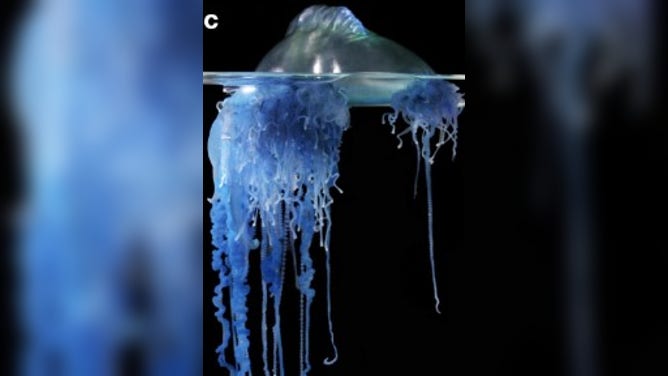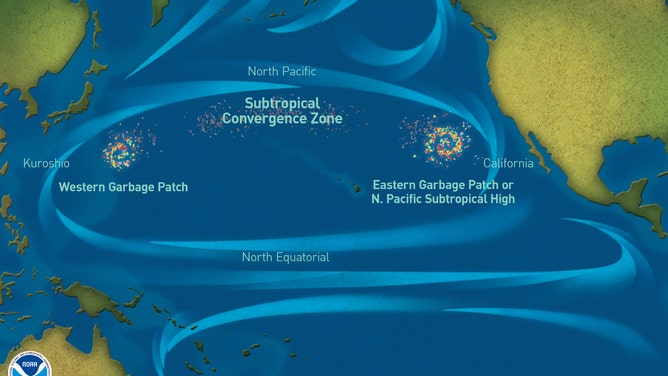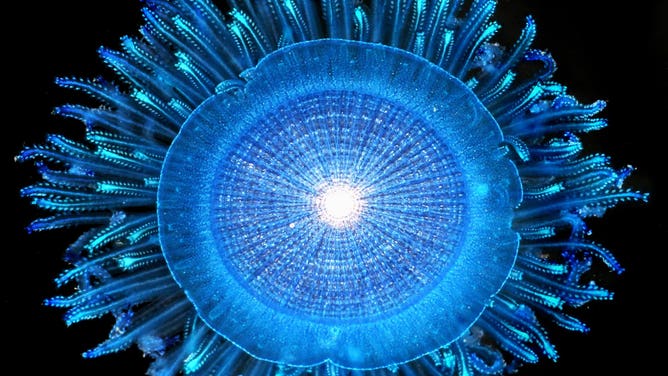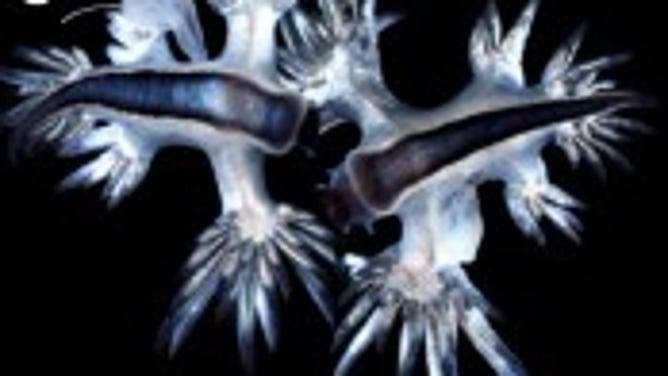Great Pacific Garbage Patch home to breeding ground for jellyfish, Portuguese man-o-war, study finds
Scientists knew there must be more places in the ocean teeming with fish like jellyfish, man-o-war and snails that can't propel themselves besides the Sargasso Sea. The search took them to the Great Pacific Garbage Patch.
Man swims through Great Pacific Garbage Patch, crew collects ocean samples
Swimmer Ben Lecomte swam 400 miles through the garbage patch for the Vortex Swim in 2019. The crew in his chase boat collected samples for this study. FOX 2 KTVU interviewed the man during the effort.
Scientists think they finally unraveled the mystery of where animals that depend on ocean currents to move live. Their life begins and thrives in the most unlikely of spots – the North Pacific Garbage Patch.
According to a study that was published Thursday in the journal PLOS Biology, the oceanic trash bin for plastics and floating debris, twice the size of Texas, was teaming with floating neuston, surface-dwelling organisms which are key strands of the ocean surface food web. Those organisms aren't limited to animals such as jellyfish and Portuguese man-o-war, but also mollusks, barnacles and algae, which larger animals like birds, turtles and fish feed on.
NEVER-BEFORE-SEEN FISH FOUND MORE THAN 3 MILES UNDER THE SEA
The scientists wrote that until this study, they had found only one area of the world teeming with the floaters, the Sargasso Sea in the North Atlantic. The scientists called the area, "a marine biodiversity hotspot supported by neuston."
The Sargasso Sea lies within the North Atlantic Subtropical Gyre and is bounded by four ocean currents. One of those currents is the Gulf Stream which delivers warm ocean water to Florida beaches and up the eastern seaboard to Cape Cod, where it heads to Europe.
RECENTLY DISCOVERED ‘SEA BUGS’ CAN GROW UP TO 1.5 FEET, EAT ENTIRE ALLIGATOR CORPSE

This is a side view of a Portuguese man-o-war.
(Denis Riek / FOX Weather)
According to NOAA’s National Ocean Service (NOS), a gyre is an extensive system of rotating ocean currents driven by wind, tides, differences in temperature and the salinity of the ocean.
The North Pacific Gyre between Hawaii and California collects trash, so the researchers surmised that the gyre would also concentrate the surface creatures, just like it did garbage in the North Pacific Garbage Patch. They sifted through trash to find a breeding ground.
To survive and reproduce, many of the species of floating animals need to be in high concentrations, so they can literally bump into one another to mate or into prey to feed. Those areas also become the feeding ground for other animals.

While "Great Pacific Garbage Patch" is a term often used by the media, it does not paint an accurate picture of the marine debris problem in the North Pacific Ocean. Marine debris concentrates in various regions of the North Pacific, not just in one area. The exact size, content and location of the "garbage patches" are difficult to accurately predict.
(MarineDebris.NOAA.gov / NOAA)
"Ocean ‘garbage patches’ and other convergence zones may be overlooked areas of high neuston abundance and could serve similar ecological roles to the North Atlantic Sargasso Sea, providing food and habitat for diverse species and valuable economic services," stated the study. "There is an urgent need to better understand these ecosystems and the role of plastic debris."
They found that particularly where plastics were in high concentrations, so was the floating life.
Another recent study found that the Pacific Garbage Patch is also rich with marine life only found on coasts as well.
GREAT PACIFIC GARBAGE PATCH NOW THRIVING WITH MARINE LIFE, STUDY SAYS
The scientists actually partnered with a ship accompanying swimmer Ben Lecompte on his 400-mile swim across the garbage patch. The mission called the Vortex Swim in 2019 was organized to bring attention to the ocean trash problem. The crew collected samples.
The authors hope that ship activity and traffic will use the findings of seas of floating organisms within the garbage patches to minimize high seas impacts and activities.




